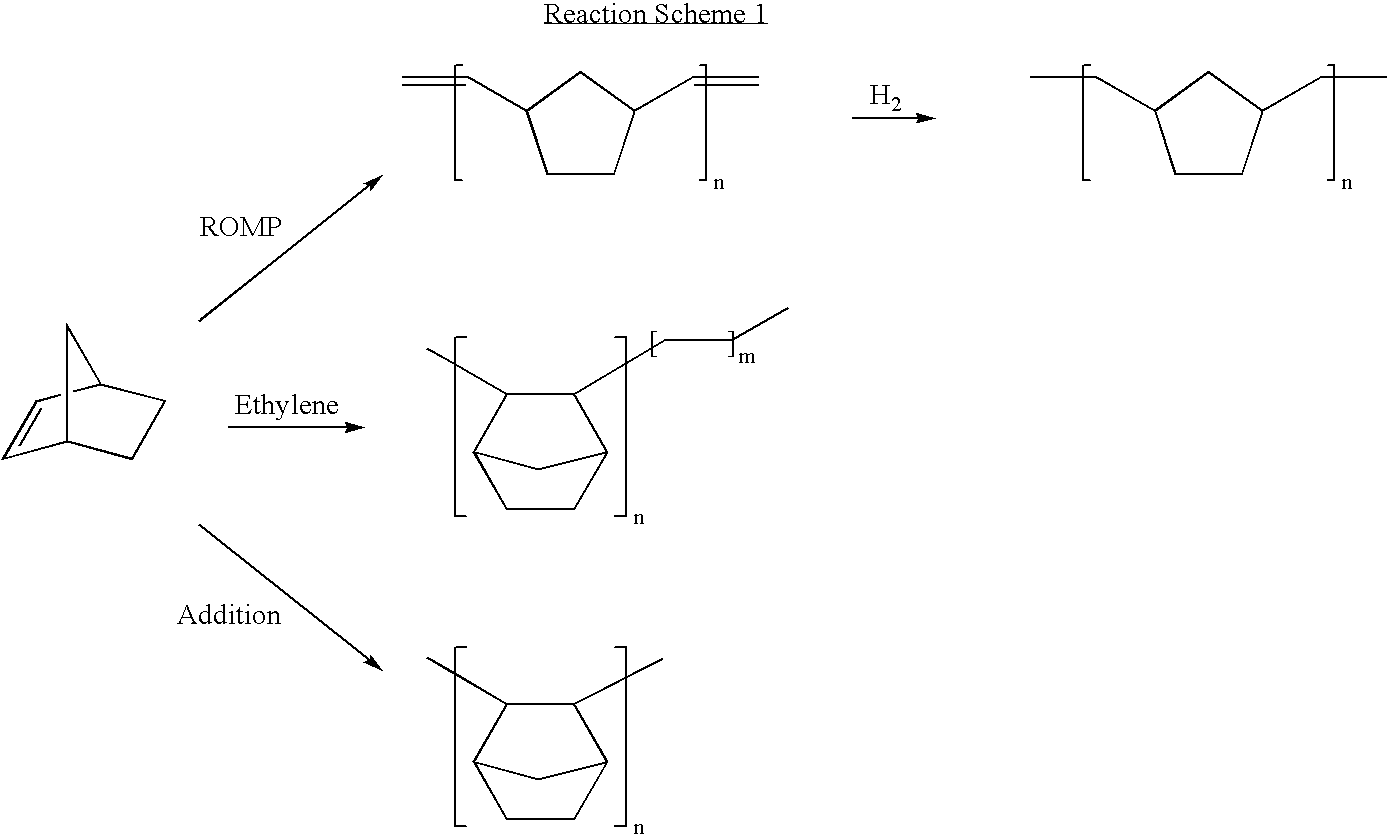Method for polymerizing cycloolefin polymer containing polar functional groups and electronic devices employing the polymerized cycloolefins
a technology of cycloolefin and functional group, applied in the field of cycloolefin polymer, can solve the problems of poor thermal and oxidative stability of polymer, increased cost due to additional processes, and deterioration of impurities remaining in the copolymer, and achieve the effect of high yield
- Summary
- Abstract
- Description
- Claims
- Application Information
AI Technical Summary
Benefits of technology
Problems solved by technology
Method used
Image
Examples
example 2
PREPARATIVE EXAMPLE 2
Preparation of endo-rich 5-norbornene-2-carboxylic acid methylester
[0103] DCPD (dicyclopentadiene, Aldrich, 256.5 mL, 1.9 mol), methylacrylate (Aldrich, 405 mL, 4.5 mol) and hydroquinone (3.2 g, 0.03 mol) were charged into a 2 L high-pressure autoclave, and the temperature was raised to 180° C. The resulting mixture was reacted for 5 hours with stirring at 300 rpm. After the reaction was completed, the reaction mixture was cooled and transferred to a distilling apparatus. The reaction mixture was distilled under a reduced pressure·(1 torr) using a vacuum pump to yield the title compound at 50° C. (yield: 85%, exo / endo=41 / 59).
[0104]1H-NMR (600 MHz, CDCl3), endo: δ 6.17 (dd, 1H), 5.91 (dd, 1H), 3.60 (s, 3H), 3.17 (b, 1H), 2.91 (m, 1H), 2.88 (b, 1H), 1.90 (m, 1H), 1.42 (m, 2H), 1.28 (m, 1H); exo: δ 6.09 (m, 2H), 3.67 (s,. 3H), 3.01 (b, 1H), 2.88 (b, 1H), 2.20 (m, 1H), 1.88 (m, 1H), 1.51 (d, 1H), 1.34 (m, 2H).
example 3
PREPARATIVE EXAMPLE 3
Preparation of 5-norbornene-2-carboxylic acid butylester
[0105] DCPD (dicyclopentadiene, Aldrich, 180 mL, 1.34 mol), butylacrylate (Junsei, 500 mL, 3.49 mol) and hydroquinone (2.7 g, 0.025 mol) were charged into a 2 L high-pressure autoclave, and the temperature was raised to 190° C. The resulting mixture was reacted for 5 hours with stirring at 300 rpm. After the reaction was completed, the reaction mixture was cooled and transferred to a distilling apparatus. The reaction mixture was distilled under a reduced pressure (1 torr) using a vacuum pump to yield the title compound at 80° C. (yield: 78%, exo / endo=55 / 45).
[0106]1H-NMR (600 MHz in CDCl3): 6.12 (m, 2H), 4.09 (t, 2H), 3.17 (s, 1H), 3.04 (s, 1H), 2.92 (m, 1H), 2.20 (m, 1H), 1.90 (m, 1H), 1.60 (m, 2H), 1.40 (m, 4H), 0.94 (t, 3H).
example 4
PREPARATIVE EXAMPLE 4
Preparation of 5-norbornene-2-carboxylic acid benzyl ester
[0107] DCPD (dicyclopentadiene, Aldrich, 67.32 mL, 0.5 mol), benzyl acrylate (Lancaster, 163 g, 1.0 mol) and hydroquinone (0.23 g, 2.1 mmol) were charged into a 2 L high-pressure autoclave, and the temperature was raised to 200° C. The resulting mixture was reacted for 5 hours with stirring at 300 rpm. After the reaction was completed, the reaction mixture was cooled and transferred to a distilling apparatus. The reaction mixture was distilled twice under a reduced pressure (1 torr) using a vacuum pump to yield the title compound at 190° C. (yield: 65%, exo / endo=56 / 44).
[0108]1H-NMR (600 MHz, CDCl3): δ 7.32 (m, 5H), 6.15-6.07 (m, 2H), 5.11-5.04 (m, 2H), 3.02˜2.88 (m, 2H), 2.96 & 2.20 (m, 1H), 1.92 (m, 2H), 1.52˜1.22 (m, 1H), 1.38 (m, 1H).
PREPARATIVE EXAMPLE 5
Preparation of 5-norbornene-2-allylacetate
[0109] DCPD (dicyclopentadiene, Aldrich, 248 ml, 1.852 mol), ally-acetate (Aldrich, 500 mL., 4.63 mol) ...
PUM
| Property | Measurement | Unit |
|---|---|---|
| temperature | aaaaa | aaaaa |
| temperature | aaaaa | aaaaa |
| temperature | aaaaa | aaaaa |
Abstract
Description
Claims
Application Information
 Login to View More
Login to View More - R&D
- Intellectual Property
- Life Sciences
- Materials
- Tech Scout
- Unparalleled Data Quality
- Higher Quality Content
- 60% Fewer Hallucinations
Browse by: Latest US Patents, China's latest patents, Technical Efficacy Thesaurus, Application Domain, Technology Topic, Popular Technical Reports.
© 2025 PatSnap. All rights reserved.Legal|Privacy policy|Modern Slavery Act Transparency Statement|Sitemap|About US| Contact US: help@patsnap.com



